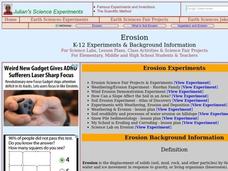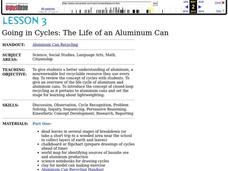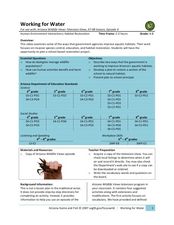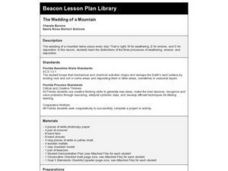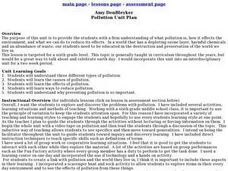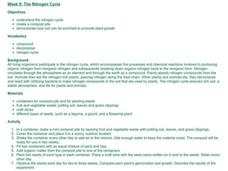Curated OER
MLTI region
For this MLTI region worksheet, students answer multiple choice questions about the MLTI region and other NASA missions. Students answer four questions.
Curated OER
Erosion
Students examine soil erosion and what causes it. In this soil lesson students complete several experiments on soil erosion and the weathering process.
Curated OER
Earthquake Waves
In this waves worksheet, students read about the different types of waves associated with earthquakes. Then students complete 1 fill in the blank and 2 short answer questions.
Curated OER
Lunar Field Trip
Learners take a virtual tour on Google Moon of what human life would be like on the moon. In this moon lesson plan, students also compose web diagrams, make charts, make a time line, investigate problems, and more.
Curated OER
Global Warming Quiz
In this global warming quiz worksheet, students compete a set of 12 multiple choice questions. Page contains a links to answers and additional activities.
Curated OER
Rock Collecting
Students practice classifying rocks in the categories sedimentary, igneous, and metamorphic. They bring personal rock collections to school, then correctly label the three types of rocks on posterboard.
Curated OER
Going in Cycles: The Life of an Aluminum Can
Students investigate the manufacture of aluminum cans and consider the energy and resources saved when the cans are made from recycled material. They explore the concept of closed-loop recycling using charts, worksheets and discussion.
Curated OER
Sediment Deposition Lab
Learners set up a stream table, observe erosion, and record data on where various sizes of sediments settle. They draw conclusions as to what kind of sedimentary rock form in what locations.
Curated OER
Wetlands: Pave or Save?
Students discuss the characteristics of wetlands and how to make them more productive. Using a map, they locate the major wetlands in the United States and color them using a key. They read an article and in groups answer discussion...
Curated OER
USING YEAST AS AN ULTRAVIOLET LIGHT MEASUREMENT TOOL
Pupils realize the importance of organisms as standards of measurement and experimentation.The first lab is a simple survival curve that demonstrates the effects of UV light on cells. The second lab looks at repair mechanisms of the DNA...
Curated OER
Going in Cycles: The Life of an Aluminum Can
Students explore the life cycle of aluminum cans. In this recycling lesson, students review the manufacturing process and how to make a closed loop cycle. Students also have the opportunity to present what they've learned to others...
Curated OER
Working for Water
Students examine the ways that government works to help improve aquatic habitats. In this water habitats lesson students view a video and plan a school restoration project.
Curated OER
Erosion Patterns
Fifth graders explore erosion and the different types of sediment. In this erosion patterns instructional activity students complete an activity and divide into groups and conduct an experiment.
Curated OER
Puerto Rican Parrot Paradise
Young scholars investigate the environment of the Puerto Rican Parrot. They visualize the ecosystem with and without information. They conduct research to find information and participate in classroom discussion to demonstrate...
Curated OER
Baleen Whales vs. Toothed Whales
Second graders review mammal characteristics and study two types of whales. In this mammal study lesson, 2nd graders discuss mammals and define their five characteristics. Students complete a whale worksheet and define differences...
Curated OER
The Wedding of a Mountain
Students examine the differences between weathering, erosion, and deposition as it pertains to mountains.
Curated OER
Pollution Unit Plan
Sixth graders examine what pollution is and the ways in which it effects the environment. They investigate ways to reduce it effects in this unit of lessons.
Curated OER
The Nitrogen Cycle
Students design and create a compost pile in order to study the Nitrogen Cycle. They then use the scientific method to determine if plants grow better when they add organic matter from their compost pile to the plant's soil.
Curated OER
What is the Composition of Soil?
Students examine the different components that make up soil. Using data, they identify the components of soil in their local area and discover how scientists use the soil to see how it was formed. They also describe the soil forming...
Curated OER
LOSING GROUND
Students will observe wind erosion and how crop residue prevents erosion.Point out the three kinds of fields to the students. Do as much or as little instruction as needed to explain the pan with crop residue. Conservation tillage...
Curated OER
Bite Sized Core Sampling
Students define the origin of rock samples and how surface core samples can tell us about the history and make-up of Mars. Candies are used as a Martian surface sample. Students study the samples and make a hypothesis about the cause of...
Curated OER
Thermal Waters & Geologic Provinces
Students investigate thermal waters and geologic provinces. They examine provided maps of geothermal springs and thermal wells in the state of Idaho and their locations relative to Idaho's geologic provinces. Afterward, they use the maps...
Curated OER
The History of Life
In this history of life worksheet, students complete a crossword puzzle by figuring out the vocabulary words associated with the 11 clues given. Then students review how paleontologists use fossils to learn more about past living things...
Curated OER
Sunlight and Warm Air
Students discuss radiant energy from the sun, performing a simple experiment with sun glasses and bright light to demonstrate the concept. Students further participate in simple in-class experiments to demonstrate: air density as it...

